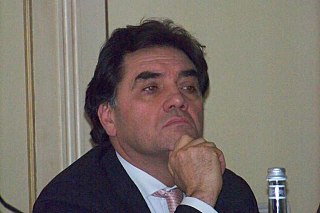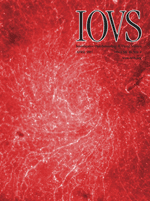
Myopia, also known as near-sightedness and short-sightedness, is an eye disease where light from distant objects focuses in front of, instead of on, the retina. As a result, distant objects appear blurry while close objects appear normal. Other symptoms may include headaches and eye strain. Severe myopia is associated with an increased risk of macular degeneration, retinal detachment, cataracts, and glaucoma.
Vision science is the scientific study of visual perception. Researchers in vision science can be called vision scientists, especially if their research spans some of the science's many disciplines.
A spasm of accommodation is a condition in which the ciliary muscle of the eye remains in a constant state of contraction. Normal accommodation allows the eye to "accommodate" for near-vision. However, in a state of perpetual contraction, the ciliary muscle cannot relax when viewing distant objects. This causes vision to blur when attempting to view objects from a distance. This may cause pseudomyopia or latent hyperopia.

Pigment epithelium-derived factor (PEDF) also known as serpin F1 (SERPINF1), is a multifunctional secreted protein that has anti-angiogenic, anti-tumorigenic, and neurotrophic functions. Found in vertebrates, this 50 kDa protein is being researched as a therapeutic candidate for treatment of such conditions as choroidal neovascularization, heart disease, and cancer. In humans, pigment epithelium-derived factor is encoded by the SERPINF1 gene.

Pedram Hamrah is a German-American ophthalmologist and immunologist. He obtained his M.D. from the University of Cologne, Germany.

King-Wai Yau is a Chinese-born American neuroscientist and Professor of Neuroscience at Johns Hopkins University School of Medicine in Baltimore, Maryland.
The Association for Ocular Pharmacology and Therapeutics (AOPT) is an organization that welcomes members from disciplines related to ocular pharmacology and its therapeutic applications. The mission of AOPT is the sustenance of a scientific network aiming the dissemination of knowledge in the field of ocular disease, pharmacology and therapeutics.

Reza Dana is the Claes H. Dohlman Professor of Ophthalmology, senior scientist and W. Clement Stone Clinical Research Scholar at Massachusetts Eye and Ear, Harvard Medical School, and director of the Harvard-Vision Clinical Scientist Development Program.

Filippo Drago is an Italian pharmacologist, neurologist and psychiatrist.

Farhad Hafezi is a prominent Swiss eye surgeon and researcher. Hafezi first gained recognition as a leading retina researcher in 1994, having been the first to discover a gene responsible for light-induced retinal degeneration. However, he changed his research focus to the cornea in 2003, and it is this work, particularly on corneal collagen cross-linking (CXL), which he helped pioneer, and advanced laser refractive surgery that he is internationally known for today. Hafezi's current clinical and laboratory research is focused on gaining a better understanding of the cornea. His research group at the University of Zurich has three main research foci:
Joan Whitten Miller is a Canadian-American ophthalmologist and scientist who has made notable contributions to the treatment and understanding of eye disorders. She is credited for developing photodynamic therapy (PDT) with verteporfin (Visudyne), the first pharmacologic therapy for retinal disease. She also co-discovered the role of vascular endothelial growth factor (VEGF) in eye disease and demonstrated the therapeutic potential of VEGF inhibitors, forming the scientific basis of anti-VEGF therapy for age-related macular degeneration (AMD), diabetic retinopathy, and related conditions.

Emily Ying Chew is an American ophthalmologist and an expert on the human retina with a strong clinical and research interest in diabetic eye disease and age-related eye diseases. She currently works for the National Eye Institute (NEI) at the National Institutes of Health (NIH) in Bethesda, Maryland, where she serves as deputy director of the Division of Epidemiology and Clinical Applications (DECA) and the Institute's deputy clinical director. She designs and implements Phase 1, 2 and 3 clinical trials at the NIH Clinical Center. Chew is board certified in ophthalmology.

Daniel M. Albert is an American ophthalmologist, ocular cancer researcher, medical historian, and collector of rare books and ocular equipment. As of 2018, he is Professor of Ophthalmology at the Casey Eye Institute, Oregon Health & Science University.
Patricia Ann D'Amore is a professor at Harvard Medical School, where she is the Charles L. Schepens Professor of Ophthalmology, and Professor of Pathology.
The Association for Research in Vision and Ophthalmology is an American learned society dedicated to ophthalmology and other vision-related topics. It is based in Rockville, Maryland.
Herbert Edward Kaufman is an American ophthalmologist who discovered idoxuridine, the first clinically useful antiviral agent; co-developed with William Bourne the clinical specular microscope to view the live corneal endothelium, co-developed timolol with Thomas Zimmerman, a new class of medications to treat glaucoma; corneal storage media for eye banks; natamycin, the first commercially available medication to treat fungal infections of the eye; co-developed with Tony Gasset the use of bandage contact lenses; and was involved in the first laser vision photorefractive keratectomy of the eye with Marguarite McDonald.
Alon Harris is an American clinical scientist, professor of ophthalmology and Professor of Artificial Intelligence and Human Health, educator, inventor and researcher in the field of ocular blood flow and its relationship to diseases of the eye. Harris served as the principal or co-principal investigator on more than 60 research grants, published more than 392 peer-reviewed articles, and wrote 23 books and 70 book chapters. As of 2021, he holds two patents. Harris sits on the Board of Directors and the Scientific Advisory Board of The Glaucoma Foundation and is the Vice Chair of International Research and Academic Affairs, co-director of the Center for Ophthalmic Artificial Intelligence and Human Health at Mount Sinai Hospital, and Director of the Ophthalmic Vascular Diagnostic and Research Program at Icahn School of Medicine at Mount Sinai.

Alfredo Arrigo Sadun is an American ophthalmologist, academic, author and researcher. He holds the Flora L. Thornton Endowed Chair at Doheny Eye Centers-UCLA and is Vice-Chair of Ophthalmology at UCLA.
Sheila Kay West is an American ophthalmologist who is the El-Maghraby Professor of Preventive Ophthalmology at the Wilmer Eye Institute. She is also the vice-chair for Research.
Russell Van Gelder is an American clinician-scientist and a board-certified ophthalmologist. He is most known for his work in the mechanisms of uveitis disease, his research on non-visual photoreception in the eye, and on vision-restoration methods for retinal degenerative disease.










